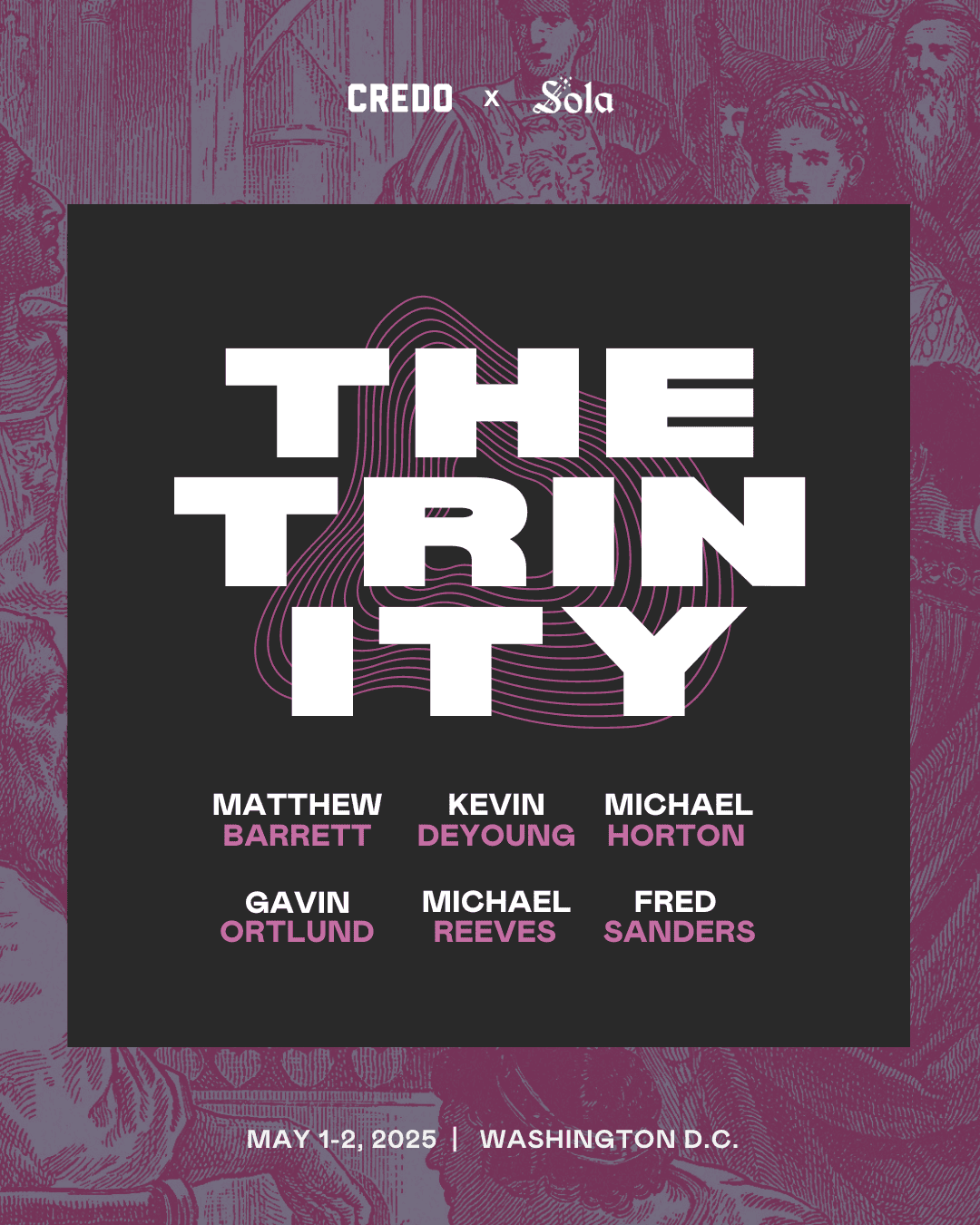Many Christians today are familiar with the Apostles’ Creed. But from the perspective of the whole church, the Nicene Creed is even more significant. It originated earlier than the final version of the Apostles’ Creed; and unlike that one, the Nicene Creed is used by both western and eastern Christians. Where did the Nicene Creed come from—and what makes it so important that millions of Christians still recite it every Sunday?
To trace the history of the Nicene Creed, which centers on the relationship of Christ’s deity to God the Father’s, we must go back to the period of the ancient church. Yet in truth, that isn’t far enough back. The roots of the doctrine of the Trinity—that the Father, Son, and Holy Spirit are distinct from one another, yet are one God—can be found in Israel’s understanding of how Yahweh interacts with his creation.
The Trinity in the Old Testament?
The early Israelites viewed God as enthroned in a heavenly temple. The heavens were located just above the solid blue dome called the “firmament” which we appear to see when we observe the sky. We know the  Israelites understood God to be sitting in a temple resting upon the firmament because twice in Scripture, his people looked up and saw him there. In Exodus 24:9–10, we read that Moses and his assistants went up a mountain and “saw the God of Israel. There was under his feet as it were a pavement of sapphire stone, like the very heaven for clearness.” Similarly, Ezekiel 1:26 records that “above the firmament over [the living creatures’] heads was the likeness of a throne, in appearance like a sapphire stone; on the likeness of the throne was a likeness with the appearance of a man” (i.e., Yahweh, v. 28). For the Israelites, God was up there in the sapphire-blue heaven, resting his feet on the firmament. He certainly didn’t come down like other gods to wreak havoc, impregnate women, or do any of the other nonsense that the pagans believed.
Israelites understood God to be sitting in a temple resting upon the firmament because twice in Scripture, his people looked up and saw him there. In Exodus 24:9–10, we read that Moses and his assistants went up a mountain and “saw the God of Israel. There was under his feet as it were a pavement of sapphire stone, like the very heaven for clearness.” Similarly, Ezekiel 1:26 records that “above the firmament over [the living creatures’] heads was the likeness of a throne, in appearance like a sapphire stone; on the likeness of the throne was a likeness with the appearance of a man” (i.e., Yahweh, v. 28). For the Israelites, God was up there in the sapphire-blue heaven, resting his feet on the firmament. He certainly didn’t come down like other gods to wreak havoc, impregnate women, or do any of the other nonsense that the pagans believed.
So, then, how did God interact with his world? Scripture gives us numerous words and images to describe how God’s transcendent presence becomes immanent in our world (that is, becomes experiential or even tangible for us). These mediating influences include the Messenger of the Lord, the divine hand or finger, natural or weather-based phenomena, the breath (or wind, or Spirit) of God, fire, and perhaps most important of all—his word. Among other things, God’s word (Hebrew, dabar) is creative (Ps. 33:6; Gen. 1:3), impactful (Ps. 107:20, 147:18; Is. 9:8), and revelatory (Ps. 119:105; or any of the prophets). The Old Testament reveals that God’s word makes things happen in his creation.
Before we can turn to Christian reflection about these things, we need to make a stop with the ancient Greeks between the two testaments. The Greek philosophers talked a lot about the logos, which was their word for “word.” The logos can be divided into two kinds: the “indwelling word” and the “uttered word.” Imagine a family sitting around on a Friday night at dinnertime. The dad gets an idea in his head: pizza night! He’ll order a big pepperoni pizza and the family will be delighted. But it’s only when Dad shouts the word “Pizza!” to his family that cheers go up and stomachs start growling. The indwelling word in his mind can only make an impact on the world by being uttered. This is how the ancient Greeks thought about words.
The Theology of the Word
Scholars debate whether the apostle John was thinking of the Hebrew concept of dabar or the Greek concept of the logos when he wrote, “In the beginning was the Word” (1:1). Maybe it was a combination of both. In any case, John said that the Word—the preincarnate Christ—was there “in the beginning with God” (v. 2). But then he went on to say something else: “And the Word became flesh and dwelt among us” (1:14). Now that God’s indwelling Word has been uttered into the world, he is able to make a physical impact with his tangible, human body. And of course, the Word’s greatest impact was to submit that body to crucifixion, then attain bodily resurrection for the salvation of the cosmos.
During the centuries after the apostle John penned his gospel, the early church fathers—especially those known at the Apologists—used these ideas to explain their faith to the pagans. The Johannine concept of the Word, understood in light of Greek philosophy, came in handy to show how the Christians, on the one hand, had no pantheon of gods but were monotheists like the Jews; yet on the other hand, worshiped Jesus as Lord alongside his heavenly Father. How can God be both singular and manifold?
The early Apologists compared God’s oneness to the unity between the speaker and the spoken word—just like, in the illustration above, there is unity between the dad who cries “pizza!” and the word that inseparably belongs to him. Yet the uttered word is impactful in ways that the word within his mind is not. This makes the spoken word distinct from the speaker. Do you see how unity and distinctness are kept in balance here? The Johannine way of thinking about Jesus—known as the Logos Theology—made sense to many ancient Christians. And they even had Old Testament precedent for it in the concept of God’s dabar. The Johannine way of thinking about Jesus—known as the Logos Theology—made sense to many ancient Christians. And they even had Old Testament precedent for it. Share on X
Equal or Inferior?
Over time, some ancient church theologians began to consider whether the Logos was inferior to the God who speaks. Inferior in what way? For one thing, the Logos might not be eternal, just as the word “pizza” didn’t always exist in the dad’s mind. He thought of the word, then he uttered it—but he himself preexisted it. So the dad was already there at the moment he thought of pizza. His mental word started then. Words always have a shorter life than the thinkers who bring them forth.
The Logos also might be inferior to God because he is sent out. Words are like our messengers that we dispatch to do our will. We shoot them out when we want something done. “Scalpel!” cries the surgeon, and she receives it. “Pass the salt,” we say, and the shaker comes our way. The sending mind has more authority than the words sent out to do the mind’s bidding. So maybe Jesus the Logos is inferior because he’s the sent one? Didn’t he say that he came to obey his Father and do his will? In fact, Jesus even said, “The Father is greater than I” (John 14:28).
This theological subordinationism is reinforced by the fact that Jesus is God’s Son. In the ancient world, sons were dispatched by mighty men or patriarchs to bring the father’s message (as in the Parable of the Landowner, Matthew 21:33–46). So for these reasons, some ancient church theologians began to think of Jesus/the Son/the Logos as inferior to God—both in time (Jesus is not eternal) and in status (Jesus is not equal in divinity).
An Argument in Alexandria
In the early fourth century, these ideas reached a boiling point—and the pot first overflowed in the Egyptian city of Alexandria. The bishop there was Alexander, and he had a young assistant named Athanasius who ardently supported his view. Alexander and Athanasius couldn’t accept the idea that the Word was limited by time—that he had popped into being at the moment when God first thought of him, and before that, he didn’t exist. Instead, this mighty duo embraced a concept from their forerunner in Alexandria, the theologian Origen, one of the most brilliant minds in all of church history. Alexander and Athanasius couldn’t accept the idea that the Word was limited by time—that he had popped into being at the moment when God first thought of him, and before that, he didn’t exist. Share on X
Origen taught the idea of eternal generation. In this context, “generation” meant that the Word/Son had his source in God. After all, words are, by definition, sourced in minds. And sons, likewise, are sourced in fathers. Yet unlike our human experience of thinking about pizza or fathering a son, the Word/Son didn’t emerge at a specific point in time. Though he was truly generated from God, this is an eternal and ongoing process of divine overflow, not a moment whose beginning you could pin down with a stopwatch. God has always possessed his eternal Word.
In Alexandria, however, another view had cropped up. It had a powerful advocate in a smart and persuasive local preacher named Arius. His theological view is captured in his slogan, “There was when [the Word] was not.” That is to say, there was a time before the Word began—and this meant he was a creature whom God brought forth. Following logically from this, the Word must be an inferior being, because creatures are always inferior to their creator. Now for Arius, the Word was preeminent among creatures. He was “the firstborn of all creation” (Col. 1:15), more exalted than anything else that had been made. Yet he was still a creature, which meant he was non-eternal and on a lower level than God.
This theological debate took the ancient church by storm. Factions developed around Alexander’s eternal Savior versus Arius’s created one. To make matters worse, all of this was happening just as Emperor Constantine converted to Christianity and was trying to make this new faith the spiritual glue that held his empire together. Constantine didn’t actually care which view would win out—he just wanted agreement. So he called together a council to meet at his lakeside palace in the charming little town of Nicaea (today, İznik, Turkey). There, Constantine thought, the matter could be decided. Was Jesus co-equal and co-eternal with God, or not?
The Council of Nicaea
In the summer of AD 325, about three hundred bishops and their attendants traveled with all expenses paid to Nicaea. Most of them were from the eastern part of the empire, but there were also a few westerners, including two delegates sent by the bishop of Rome. Though we don’t know the historical details of what unfolded at Nicaea, we know the basic gist, and we know the final outcome.
The famous church historian, Eusebius of Caesarea, leaned toward the Arian view. He put forth a creed that he claimed was the long-standing creed of his hometown—a city that had apostolic origins (Acts 10:1, 18:22, 21:16). But the problem with Eusebius’s creed was that it offered no specific wording to resolve the issues at hand. It just used weasel words that would allow the Arians to keep their non-eternal Christ. The creed was full of bland—though biblical—Christological descriptors: “one Lord Jesus Christ, the Word of God, God from God, Light from Light, Life from Life, Only-begotten Son, firstborn of every creature, begotten from the Father before all the ages.” All of these statements were true. Yet none of them excluded the idea of Christ’s creaturehood. In fact, “firstborn of every creature” (quoted out of context) implied that he actually was a creature!
Eusebius’s creed was rejected at Nicaea. In order to exclude the Arian view of the Son’s creaturely status, an important word was introduced into the new creed that was formulated: “consubstantial,” or in Greek, homoousios. Scholars debate exactly where this word came from. In any case, it was put into the creed—so Eusebius tells us—to contradict the Arian view. If the Son of God is consubstantial with the Father, it means they share the same substance. And when two things share the same substance—that is, they share essential being, or what they fundamentally are—then one of them cannot precede the other. The two things are co-existent and co-equal.
With this word in the Nicene Creed, the victory of Alexander and Athanasius was complete. Arius was vanquished and the emperor banished him to a distant place (but there is no evidence whatsoever that Nicholas of Myra punched Arius—that stupid legend cropped up many centuries later). What we do know is that everybody at the council except for Arius and two other bishops voted for the insertion of homoousios into the creed. The Father and Son share the same substance, making them equally eternal and equally divine.
In the ensuing decades, imperial politics and theological wrangling meant that the Nicene Creed didn’t immediately find total acceptance in the church. Athanasius and many others kept fighting for it, but the Arians had powerful allies as well. It was only at a second church meeting, the Council of Constantinople in AD 381, that the creed finally won the day. This council’s amended version of the creed is the one we recite today as the “Nicene Creed.” It is basically the same as its predecessor, but includes more content about the deity of the Holy Spirit than the first version did. Now the doctrine of the Trinity was firmly established. The victory of the co-eternal, consubstantial view of the Trinity isn’t just an interesting historical anecdote. This doctrine matters to us today. Share on X
What Does it All Mean?
The victory of the co-eternal, consubstantial view of the Trinity isn’t just an interesting historical anecdote. This doctrine matters to us today. It’s essential to our understanding of how God loves us. Here is the reason why.
If Christ isn’t fully divine and consubstantial with the Father, it means that God sent out an inferior “proxy” to do his dirty work. God doesn’t give fully of himself, but only dispatches an agent to get things done. Perhaps we could speak of Jesus being self-giving in this scenario, since he was “obedient to the point of death, even death on a cross” (Phil. 2:8). Yet such duties are expected of a lesser being. Servants have to carry out their superior’s will. But God the Father is separate from that (supposedly) created servant whom he dispatched to the cross. This might be considered a sacrificial act on God’s part—he did send his beloved Son to death, after all—but it’s not a self-giving act if there’s no essential unity between the sender and the sent.
However, this is not the case! God the Father and God the Son are one. Together, these two persons of the Trinity, in harmony with God the Holy Spirit, cooperated to achieve our salvation. When the Son was suffering on the cross, the Father was a full participant in that suffering, since the Trinity is united. This isn’t to say that God the Father was the exact person of the Trinity who was nailed upon the cross. That’s a heresy known as modalism, or more specifically, patripassianism. Yet if the Trinity is consubstantial—if the Son is God just as much as the Father is God or the Spirit is God—then their actions are shared. Thus we can say with confidence that God loved us so much that he gave us his entire self. When the Father gave us his Son (John 3:16), he gave us one who is essentially, consubstantially, equally, and eternally united with himself. No pagan god would do such a thing. Only the Trinitarian God of Christianity possesses so great a love as this.


